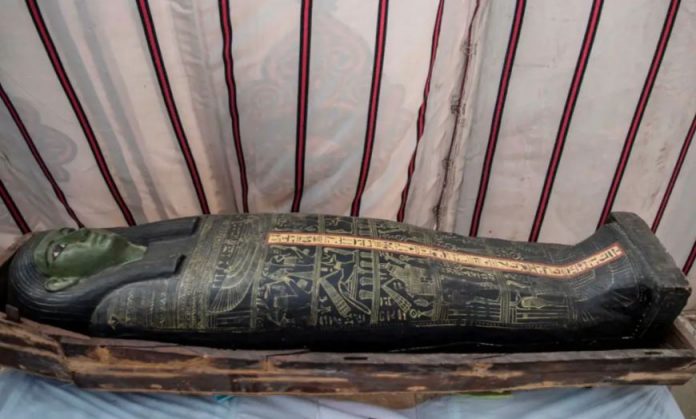For millennia, ancient Egyptians were laid to rest in burial shafts under Saqqara, a city of the dead in the desert south of modern-day Cairo.
But royal Egyptians like King Teti — a pharaoh who ruled more than 4,200 years ago — were buried in pyramids, along with the women they married. Archaeologists discovered a pyramid belonging to one of Teti’s wives at Saqqara in 2010, but her name wasn’t mentioned on the walls inside.
That gave rise to a mystery about the ancient woman’s identity — she was an unknown member of Egyptian royalty. A new finding provides the answer: Egypt’s Ministry of Antiquities announced Sunday that excavators had uncovered a funerary temple near Teti and his wife’s burial pyramids with a name on the wall: Queen Nearit.
“I’d never heard of this queen before. Therefore, we add an important piece to Egyptian history about this queen,” Zahi Hawass, head of the Saqqara archaeological mission, told CBS News.
Queen Nearit, which can also be spelled Neit, is probably not buried in the funerary temple, since these structures served primarily as place of worship where priests would honor dead royals. Other people could also visit to offer food and gifts to the deceased.
Part of the temple had been uncovered before this excavation, according to the ministry, but the recent discovery cements the identity of its owner.
Coffins buried 40 feet under the sand rewrite history
Near Nearit’s temple, archaeologists also discovered three brick warehouses containing offerings to Teti and his queen, along with tools that had been used to build her funerary temple. Additionally, they found 52 burial shafts containing more than 50 wooden coffins, or sarcophagi, that were at least 3,000 years old.
It was the first time sarcophagi that old had been found at Saqqara, according to the ministry. They’re roughly 500 years older than the most ancient coffins found in the city to date.
The discovery confirms that Egyptians buried their dead in the necropolis during the New Kingdom era, between the 16th and the 11th century BC. That’s far earlier than Egyptologists initially thought.
It will “rewrite the history of this region,” Hawass said in a statement.
One of 50 wooden sarcophagi found near Queen Nearit’s tomb at Saqqara.
The recent discovery is the latest in a series of findings from Saqqara.
Since September, researchers have found at least 160 human coffins buried below the sand, in shafts up to 40 feet deep. This latest trove brings that total up to 210 or more.
According to the archaeologists, many of the newly discovered coffins are decorated with illustrations of Egyptian gods and excerpts from the “Book of the Dead,” an ancient manuscript that guides souls through the afterlife.
Inside the all the sarcophagi found so far, presumably, are linen-wrapped bodies of ancient Egyptians whose organs were removed before burial. The mummies stayed in the sealed sarcophagi for thousands of years.
Egyptologists have opened a few of them. Archaeologists picked one Saqqara sarcophagus to open live in front of an audience at a small event in November. They conducted an immediate, real-time X-ray of the mummy inside, which revealed a short, ancient Egyptian man who’d been in good health before he died around age 40 or 45. Egyptian officials also opened a sarcophagus on stage during an October press conference.
Some of the 50 new coffins were also opened and put on display Sunday, when Hawass and ministry officials announced their recent findings.
The burial shafts contained more than just mummies
Inside the burial shafts near Nearit’s tomb, Hawass’s team found a trove of artifacts in addition to the coffins. There were funerary masks, a bronze axe from a leader of a pharaoh’s army, bird-shaped sculptures, a limestone tableau, and a shrine dedicated to the jackal-headed deity Anubis, the Egyptian god of the dead.
The archaeologists also discovered a set of board games, including one called “Senet,” a chess-like game that Egyptians believed would let a dead person make it into the afterlife — if they won.
One shaft contained a 13-foot-long, 3-foot-wide papyrus scroll as well.
The scroll was a complete chapter from the “Book of the Dead,” containing instructions for how to navigate the afterlife. It’s the first time such a large papyrus scroll has ever been discovered inside a burial shaft, Hawass said.
These discoveries probably won’t be the last Saqqara offers up. As excavations continue there, more burial shafts — and the treasures therein — are still being uncovered.
“Actually, this morning we found another shaft,” Hawass told CBS News on Monday. “Inside the shaft we found a large limestone sarcophagus. This is the first time we’ve discovered a limestone sarcophagus inside the shafts. We found another one that we’re going to open a week from now.”







